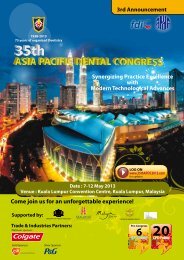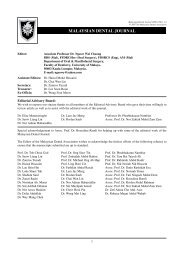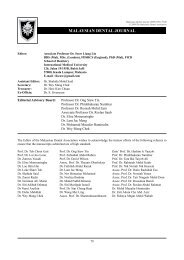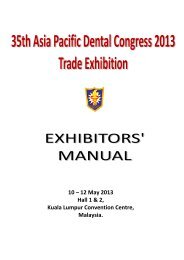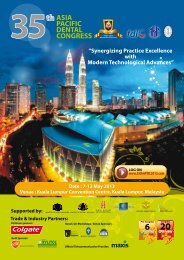PDF(6.5mb) - Malaysian Dental Association
PDF(6.5mb) - Malaysian Dental Association
PDF(6.5mb) - Malaysian Dental Association
- No tags were found...
Create successful ePaper yourself
Turn your PDF publications into a flip-book with our unique Google optimized e-Paper software.
The Loading And Unloading Properties Of Various Arch Wires As A Function Of Cross Sectional Dimension And Inter Bracket Span WidthGraph:5 - Loading of 0.017”x0.025” arch wire at 5 mmand 6.5 mm inter bracket span.X axis -- forces in Newton. ------------------ 6.5 mminterbracket spanY axis -- deflection in mm . ___________ 5mm interbracket spanL0, L1,L2,L3 – Loading on 0 mm, 1 mm, 2 mm and 3mm deflection.UL3,UL2,UL1- Unloading on 3 mm, 2 mm and 1 mmdeflection.SE NiTi – Superelastic NiTi, NiTi – Conventional NiTiSS – Stainless Steel, TMA – Titanium MolybednumalloyGraph:6 - Unloading of 0.017”x0.025” arch wire at 5mm and 6.5 mm inter bracket span.DISCUSSIONThe ideal requisite for Orthodontic toothmovement is the application of light and continuousforce. 11 Orthodontic wires which generate thebiomechanical forces are the most important factorin the application of light and continuous force. Inselection of wires for particular stage of treatment,the orthodontist should consider a variety of factorsincluding the elastic range or spring back, formabilityor ease of manipulation and load deflection rate. 12Bending tests have been popular for evaluationof the mechanical properties of archwires, especiallythe load deflection rate because of the relevanceof bending deformation to the activation received. 13Three types of bending tests are usually performed:a cantilever bending, a three point bending andfour point bending test. 12 The standard method forevaluating orthodontic wires not containing preciousmetals is the three-point elastic bending test accordingto ADA specification no.32. 11A modified version of the three point bendingby Wilkinson etal was performed in this study toevaluate the load deflection rate, the most importantparameter determining the biologic nature of toothmovement. 10 This test was chosen mainly because ofits close simulation to clinical application, reproducibleresults and the ability to differentiate wires withsuperelastic property. Cross section speed 10 for theload cell was chosen as 2 mm per minute to simulatethe clinical situation of biologic tooth movement. Theinterbracket span was chosen as 5 mm simulating amalaligned lower lateral incisor and 6.5 mm simulatinga malaligned upper lateral incisor. 8Large interbracket distance, smaller dimensionwires and as much as intra bracket space as possibleis needed to get the greatest range or flexibility oforthodontic wires. 14 The use of 0.018 inch slot bracketincreases control, but sacrifices some of the flexibilityassociated with intrabracket space. So in this study,0.022” slot pre-adjusted edgewise brackets of Rothprescription were embedded in the partial acrylicblocks 1 and 2 to simulate the clinical condition. 10,15The modulus of elasticity in bending can becalculated from the force deflection plot using equationfrom solid mechanics. For three point bending, themaximum deflection (y) of the beam is given byy=FL3/48EI, where F is the applied force, L is the testspan length, E represents the modulus of elasticity andI is the moment. 9The vertical axis of the force deflection plotrepresents force or bending moment and the horizontalaxis represents the deflection or range. The clinicalrelevance of the load/deflection plot are the stiffnesswhich is the slope of the initial linear region, the forceor moment at which yielding takes place and the valueof deflection at the elastic limit termed the range. 16Since Stainless steel is the most commonlyused arch wire material, it was compared to superelastic NiTi, beta titanium (TMA) and conventional NiTiwires to differentiate their mechanical properties. Theresults revealed a linear progression during loadingof stainless steel arch wire for different wire crosssection and additionally there was an increase inforce value with increasing wire cross section. Onunloading, Stainless steel did not show any force valuebecause of the permanent deformation. This findingwas similar for the varying inter bracket span in spite ofthe reduced force values with increased inter bracketspan. 17 The stainless steel wires delivered twice the<strong>Malaysian</strong> <strong>Dental</strong> Journal Jan-Jun 2011 Vol 32 No 138



